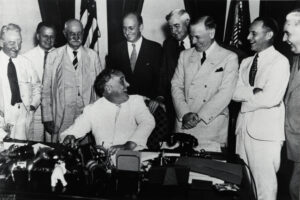
This year marks the ninetieth anniversary of the Banking Act of 1935, the law that gave the Federal Reserve its current structure. Often overshadowed by the 1933 Act, which created deposit insurance and separated commercial from investment banking, the 1935 Act was just as important. By shifting power to Washington and redefining the Fed’s role, it built the framework for modern US monetary policy.
In its early years, the Fed — founded in 1913 when President Woodrow Wilson signed the Federal Reserve Act — looked very different.
Each regional Reserve Bank conducted open market operations on its own, deciding which securities to buy and at what price. Because US markets were so interconnected, one bank’s actions spilled into other districts, leaving monetary policy pulling in different directions. This wasn’t a flaw so much as a feature of the system’s decentralized design. But it didn’t work well in practice.
To bring some order, five Reserve Banks — Boston, Chicago, Cleveland, New York, and Philadelphia — formed a committee in 1922 to coordinate their trades. A year later, it became the Open Market Investment Committee (OMIC), which operated under the Board’s supervision in Washington. But the arrangement was voluntary. Other Reserve Banks could still go their own way, even if they rarely did.
In 1930, the OMIC gave way to the Open Market Policy Conference (OMPC), which included all twelve Reserve Bank governors (later retitled “presidents” by the 1935 Act). A smaller five-member group, comprising the original OMIC members, carried out the trades. But, again, participation was voluntary, and regional banks retained the right to act independently.
That freedom became a liability in the summer of 1932, when disagreements among the Reserve Banks led to a breakdown of cooperation. The result was to deepen the Great Contraction of the money supply that had begun in 1929. The Banking Act of 1933 addressed this issue by creating the Federal Open Market Committee (FOMC). Like the OMPC, it included all twelve Reserve Bank governors. Unlike the OMPC, the FOMC’s decisions were binding.
Careful readers will notice that today’s FOMC looks very different. Instead of twelve Reserve Bank presidents, it includes the seven members of the Board of Governors in Washington and five Reserve Bank presidents: the New York Fed president and four of the remaining eleven on rotation. The 1935 Act established this structure, giving the Board a majority on the committee for the first time. That change remains one of the Act’s enduring legacies: the centralization of monetary policy in Washington, DC.
The 1935 Act went further still. It gave the Board direct authority over other key tools of monetary policy. The Board could now set reserve requirements, regulate interest rates on member bank deposits, and approve the discount rates Reserve Banks charged when lending to commercial banks.
Previously, each Reserve Bank set its own discount rate. The Board could sign off, but lacked the power to force changes or to impose a uniform national rate. The 1935 Act changed that. From then on, the Board could compel changes and, if it wished, establish a single discount rate for the entire country.
Finally, the Act strengthened the Fed’s independence. Before 1935, the Treasury Secretary and the Comptroller of the Currency sat on the Federal Reserve Board, with the Treasury Secretary serving as its chair. The Act removed them, creating a new Board of Governors composed solely of presidential appointees serving long, staggered terms, with a separate chair nominated by the President. Around the same time, the Fed left the Treasury Building for its own headquarters on Constitution Avenue. The Fed’s move was both a symbolic and practical marker of independence.
Ninety years later, every Fed decision — from raising rates to curb inflation to cutting them in a downturn — still flows through the framework the 1935 Act created. By redesigning the FOMC, consolidating control over monetary tools, and strengthening independence from the Treasury, the law built the modern Federal Reserve.
Yet centralization has tradeoffs.
The Act reduced the influence of regional banks, gave New York a privileged seat, and concentrated power in Washington — a trend extended by later reforms like Dodd–Frank, which limited the banking sector’s role in selecting Reserve Bank presidents. Centralization freed the Fed from Wall Street and the Treasury, but it also concentrated authority in Washington, where political pressures are never far away — a tension that continues to shape monetary policy to this day.
